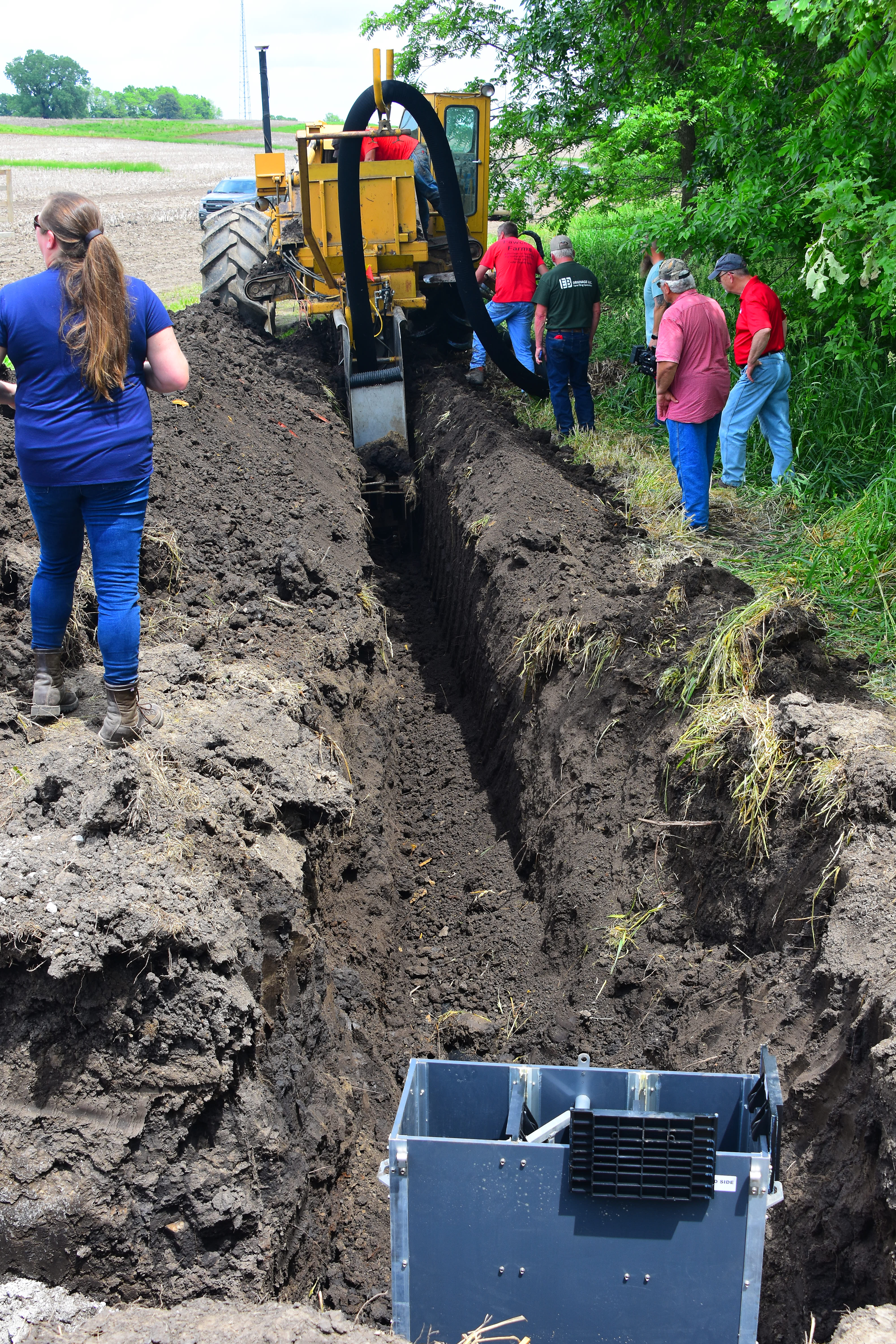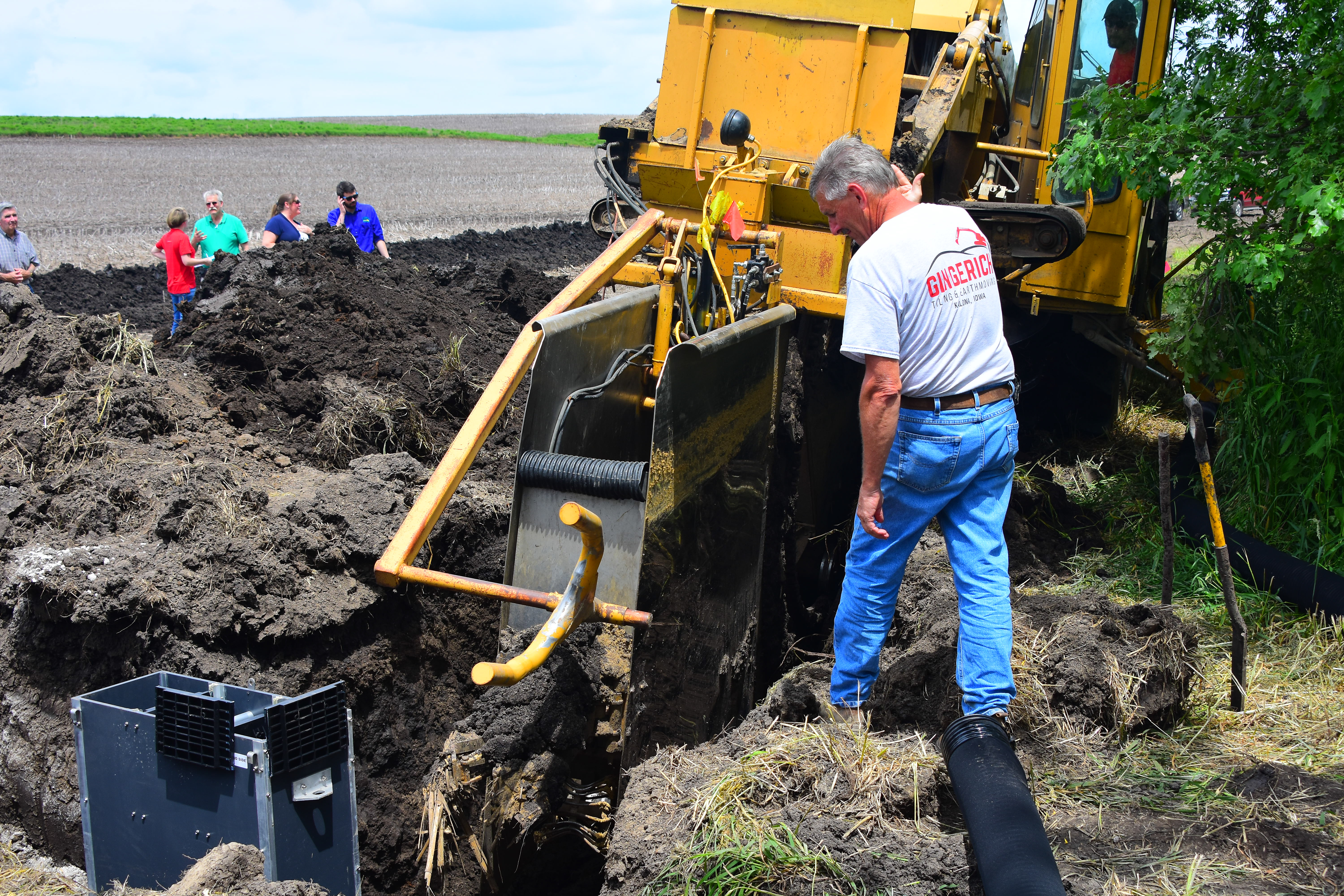Partners help farmers improve land, water quality
By Kurt Lawton
New funding, new partners, and relatively new conservation practices are coming together to help farmers and land owners improve water quality.
Public and private partners came together recently to help farmers Kent Stuart and Ken Fawcett install a saturated buffer during a field day at their farm near West Branch, Iowa.
"A good friend, Bruce Barnhart with the Iowa Chapter of the Land Improvement Contractors Association (LICA), and our tile contractor Eric Brown got the process started,” says Stuart. The LICA members put Stuart in touch with the Iowa Agriculture Water Alliance, Agri Drain, and Ecosystem Services Exchange to develop and implement a plan.
The LICA members put Stuart in touch with the Iowa Agriculture Water Alliance, Agri Drain, and Ecosystem Services Exchange to develop and implement a plan.
“It would have been an easy year to say the challenges are too great and it’s too uncertain and we aren’t going to do it,” says Barnhart about the installation and field day. “LICA commends the whole team for their persistence.”
Stuart understood there could be cost-share available. But, with the quick timeline desired (March to June), he felt there wasn't time to achieve funding and approvals. "Thankfully, these partners helped defray some costs because everyone wants to see these saturated buffers work in this area,” he says.
Tile installer, Eric Brown, owner of EB Drainage, enjoyed working with Agri Drain and Ecosystem Services Exchange to install a water level control structure for this saturated buffer. "From a business perspective, any conservation work we get is great. It helps preserve the land and reduce nitrate in tile for our customers, and consumers, while increasing work for us during times when we're not as busy," Brown says.
Conservation Infrastructure Initiative
This farmer, landowner, public/private partnership effort is another example of how the Conservation Infrastructure initiative works to quicken the pace and scale of conservation practices in Iowa. The Conservation Infrastructure initiative, co-led by the Iowa Agriculture Water Alliance (IAWA) and the Iowa Department of Agriculture and Land Stewardship (IDALS), aims to help producers meet the goals of the Iowa Nutrient Reduction Strategy. Plus, it showcases economic opportunities for private companies to start or expand conservation-related businesses.
Shane Wulf, who coordinates edge-of-field practices for IDALS, helps organize these types of partnership efforts. "We help everyone navigate the different programs to get nutrient reduction practices on the ground faster — like cover crops, no-till and strip till, as well as edge-of-field practices," he says.
Wulf knows and appreciates landowners’ and farmers' patience when utilizing state and federal programs, as NRCS design standards are followed. "It is important to work together as a team to understand the challenges and help navigate different strategies to find the best solutions," he says. "By partnering at field days, to demonstrate and educate, we gain interest from a larger group, compared to a seminar. We give local farmers and contractors an actual practice to see, and hopefully implement in the future."
Charlie Schafer, President of Agri Drain and co-lead of the Conservation Infrastructure initiative's Conservation Drainage Working Group, sees these partnerships as vitally important to assist the industry. "It's important to provide solutions to water quality-related issues, not just for the land improvement and drainage industry, but for agriculture in general," he says.
"When we can work together and install high-performance water management systems for the benefit of growers to reduce risk — and still provide outstanding environmental outcomes —that's a win-win for consumers, producers, environmentalists, and all involved," Schafer adds.
 Also attending the field day was LICA's Iowa Chapter Executive Director Melanie Bohle. She firmly believes the work with partners to showcase practices at field days will continue to be valuable going forward. "Contractors learn so much more by seeing it completed, just as we have demonstrated on our LICA farm over the years," she says. "We're excited to be working with IAWA on these types of educational field days around the state, for producers and contractors."
Also attending the field day was LICA's Iowa Chapter Executive Director Melanie Bohle. She firmly believes the work with partners to showcase practices at field days will continue to be valuable going forward. "Contractors learn so much more by seeing it completed, just as we have demonstrated on our LICA farm over the years," she says. "We're excited to be working with IAWA on these types of educational field days around the state, for producers and contractors."
Producer groups — including Iowa Corn, the Iowa Soybean Association, and the Iowa Pork Producers Association— along with environmental groups like The Nature Conservancy also are sponsors and big promoters of conservation and water quality practices.
Sean McMahon, Executive Director of IAWA, says these combined efforts all help further the Conservation Infrastructure initiative. "By increasing the investment and engagement from both the public and private sectors, we continue to accelerate the adoption of conservation practices to help achieve the goals of the Iowa Nutrient Reduction Strategy,” he says.
To learn more about this Fawcett Farm saturated buffer installation, read this story.